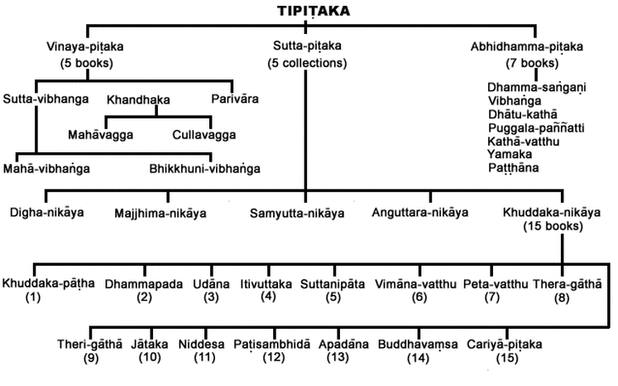2519 Thu 1 Feb 2018 LESSON
May all be Happy, Welland Secure!
May all Liver Long!
May all have calm, quiet, alert, attentive and Equanimity Mind with a clear understanding that Everything is Changing!

23 Classical English
and related NEWS through http://sarvajan.ambedkar.org in 105
CLASSICAL LANGUAGE
Tipiṭaka Studies for University Students

Structured Tree Flow of
https://www.accesstoinsight.
The Tipitaka (Pali ti, “three,
or Pali canon, is the collection of primary Pali language texts which
form the doctrinal foundation of Theravada Buddhism. The Tipitaka and
the paracanonical Pali texts (commentaries, chronicle
The
Pali canon is a vast body of literature: in English translation the
texts add up to thousands of printed pages. Most (but not all) of the
Canon has already been published in English over the years. Although
only a small fraction of these texts are available on this website, this
collection can be a good place to start.
The three divisions of the Tipitaka are:
- Vinaya Pitaka
- The collection of texts concerning the rules of conduct governing the daily affairs within the Sangha — the community of bhikkhus (ordained monks) and bhikkhunis (ordained
nuns). Far more than merely a list of rules, the Vinaya Pitaka also
includes the stories behind the origin of each rule, providing a
detailed account of the Buddha’s solution to the question of how to
maintain communal harmony within a large and diverse spiritual
community. - Sutta Pitaka
- The
collection of suttas, or discourses, attributed to the Buddha and a few
of his closest disciples, containing all the central teachings of
Theravada Buddhism. (More than one thousand sutta translations are
available on this website.) The suttas are divided among five nikayas (collections):- Digha Nikaya — the “long collection”
- Majjhima Nikaya — the “middle-length collection”
- Samyutta Nikaya — the “grouped collection”
- Anguttara Nikaya — the “further-factored collection”
- Khuddaka Nikaya — the “collection of little texts”:
- Khuddakapatha
- Dhammapada
- Udana
- Itivuttaka
- Sutta Nipata
- Vimanavatthu
- Petavatthu
- Theragatha
- Therigatha
- Jataka
- Niddesa
- Patisambhidamagga
- Apadana
- Buddhavamsa
- Cariyapitaka
- Nettippakarana (included only in the Burmese edition of the Tipitaka)
- Petakopadesa ( ” ” )
- Milindapañha ( ” ” )
- Abhidhamma Pitaka
- The
collection of texts in which the underlying doctrinal principles
presented in the Sutta Pitaka are reworked and reorganized into a
systematic framework that can be applied to an investigation into the
nature of mind and matter.
For further reading
- Where can I find a copy of the complete Pali canon (Tipitaka)? (Frequently Asked Question)
- Beyond the Tipitaka: A Field Guide to Post-canonical Pali Literature
- Pali Language Study Aids offers links that may be useful to Pali students of every level.
- Handbook of Pali Literature, by
Somapala Jayawardhana (Colombo: Karunaratne & Sons, Ltd., 1994). A
guide, in dictionary form, through the Pali canon, with detailed
descriptions of the major landmarks in the Canon. - An Analysis of the Pali Canon, Russell
Webb, ed. (Kandy: Buddhist Publication Society, 1975). An indispensable
“roadmap” and outline of the Pali canon. Contains an excellent index
listing suttas by name. - Guide to Tipitaka, U
Ko Lay, ed. (Delhi: Sri Satguru Publications, 1990). Another excellent
outline of the Tipitaka, containing summaries of many important suttas. - Buddhist Dictionary, by
Nyanatiloka Mahathera (Kandy: Buddhist Publication Society, 1980). A
classic handbook of important terms and concepts in Theravada Buddhism.
Help | Site map | About | Contact | Terms of use
The
ultimate objective in Buddhism is attained by purifying and improving
mind. However, understanding what “mind” is a quite complicated act for
any person. This is a barrier for someone who is interested in learning
Buddhism in-depth. One of the teachings in Buddhism which provides a
comprehensive analysis on mind is “Abhidhamma”.
The Buddhist doctrine
is categorized into three, which is known to anyone, as “Thripitaka”
namely Suthra Pitaka, Vinya Pitaka and Abhidhamma Pitaka. Vinaya Pitaka
consists rules of conduct for Sangha and Suthra Pitaka consists of
Suttas containing the central teachings of Buddhism. Suthra Pitaka is
mostly on “Conventional Teachings” (Sammuthi Dheshana) of Buddhism.
Abhidhamma Pitaka provides a theoretical framework for the doctrine
principles in Suthra Pitaka which could be used to describe “Mind and
Matter”. Hence, Abhidhamma embraces the “Ultimate Teachings”
(Paramaththa Dheshana) in Buddhism.
Abhidhamma Pitaka consists of seven treatises;
1. Dhammasangani
2. Vibhanga
3. Dhatukatha
4. Puggalapannatti
5. Kathavatthu
6. Yamaka
7. Pattthana
The
term “Abhidhamma” simply means “Higher Doctrine”. It is an in-depth
investigation to mind and matter. It answers many intricate points of
Dhamma. It analyses complex machinery of human, world, mind, thoughts,
thought-process, mental formations and etc. Therefore it is indeed a
complex doctrine to understand. However, there are many who are
interested in learning this beautiful branch of doctrine. Amongst them
there are plenty of non-Buddhists as well. This effort is to present
this doctrine in an “Easy to Understand” manner.

https://www.accesstoinsight.org/tipitaka/dn/index.html
Digha Nikaya
The Long Discourses
© 2005
The Digha Nikaya, or “Collection of Long Discourses” (Pali digha =
“long”) is the first division of the Sutta Pitaka, and consists of
thirty-four suttas, grouped into three vaggas, or divisions:
Silakkhandha-vagga — The Division Concerning Morality (13 suttas)
Maha-vagga — The Large Division (10 suttas)
Patika-vagga — The Patika Division (11 suttas)
An excellent modern translation of the complete Digha Nikaya is Maurice
Walshe’s The Long Discourses of the Buddha: A Translation of the Digha
Nikaya (formerly titled: Thus Have I Heard) (Boston: Wisdom
Publications, 1987). A fine anthology of selected suttas is Handful of
Leaves (Vol. 1), by Thanissaro Bhikkhu (distributed by the PTS).
The translator appears in the square brackets []. The braces {} contain
the volume and starting page number in the PTS romanized Pali edition.
DN 1: Brahmajāla Sutta — The All-embracing Net of Views {D i 1}
[Bodhi]. In this important sutta, the first in the Tipitaka, the Buddha
describes sixty-two philosophical and speculative views concerning the
self and the world that were prevalent among spiritual seekers of his
day. In rejecting these teachings — many of which thrive to this day —
he decisively establishes the parameters of his own.
DN 2:
Samaññaphala Sutta — The Fruits of the Contemplative Life {D i 47}
[Thanissaro]. King Ajatasattu asks the Buddha, “What are the fruits of
the contemplative life, visible in the here and now?” The Buddha replies
by painting a comprehensive portrait of the Buddhist path of training,
illustrating each stage of the training with vivid similes.
DN
9: Potthapada Sutta — About Potthapada {D i 178} [Thanissaro]. The
wandering ascetic Potthapada brings to the Buddha a tangle of questions
concerning the nature of perception. The Buddha clears up the matter by
reviewing the fundamentals of concentration meditation and showing how
it can lead to the ultimate cessation of perception.
DN 11:
Kevatta (Kevaddha) Sutta — To Kevatta {D i 211} [Thanissaro]. This
discourse explores the role of miracles and conversations with heavenly
beings as a possible basis for faith and belief. The Buddha does not
deny the reality of such experiences, but he points out that — of all
possible miracles — the only reliable one is the miracle of instruction
in the proper training of the mind. As for heavenly beings, they are
subject to greed, anger, and delusion, and so the information they give —
especially with regard to the miracle of instruction — is not
necessarily trustworthy. Thus the only valid basis for faith is the
instruction that, when followed, brings about the end of one’s own
mental defilements. The tale that concludes the discourse is one of the
finest examples of the early Buddhist sense of humor. [This summary
provided by the translator.]
DN 12: Lohicca Sutta — To Lohicca
{D i 224} [Thanissaro]. A non-Buddhist poses some good questions: If
Dhamma is something that one must realize for oneself, then what is the
role of a teacher? Are there any teachers who don’t deserve some sort of
criticism? The Buddha’s reply includes a sweeping summary of the entire
path of practice.
DN 15: Maha-nidana Sutta — The Great Causes
Discourse {D ii 55} [Thanissaro]. One of the most profound discourses in
the Pali canon, which gives an extended treatment of the teachings of
dependent co-arising (paticca samuppada) and not-self (anatta) in an
outlined context of how these teachings function in practice. An
explanatory preface is included.
DN 16: Maha-parinibbana Sutta —
Last Days of the Buddha/The Great Discourse on the Total Unbinding {D
ii 137; chapters 5-6} [Vajira/Story | Thanissaro (excerpt)]. This
wide-ranging sutta, the longest one in the Pali canon, describes the
events leading up to, during, and immediately following the death and
final release (parinibbana) of the Buddha. This colorful narrative
contains a wealth of Dhamma teachings, including the Buddha’s final
instructions that defined how Buddhism would be lived and practiced long
after the Buddha’s death — even to this day. But this sutta also
depicts, in simple language, the poignant human drama that unfolds among
the Buddha’s many devoted followers around the time of the death of
their beloved teacher.
DN 20: Maha-samaya Sutta — The Great
Assembly/The Great Meeting {D ii 253} [Piyadassi | Thanissaro]. A large
group of devas pays a visit to the Buddha. This sutta is the closest
thing in the Pali canon to a “Who’s Who” of the deva worlds, providing
useful material for anyone interested in the cosmology of early
Buddhism.
DN 21: Sakka-pañha Sutta — Sakka’s Questions {D ii
276; chapter 2} [Thanissaro (excerpt)]. Sakka, the deva-king, asks the
Buddha about the sources of conflict, and about the path of practice
that can bring it to an end. This discourse ends with a humorous account
about Sakka’s frustration in trying to learn the Dhamma from other
contemplatives. It’s hard to find a teacher when you’re a king.
DN 22: Maha-satipatthana Sutta — The Great Frames of Reference {D ii
290} [Burma Piṭaka Assn. | Thanissaro]. This sutta offers comprehensive
practical instructions on the development of mindfulness in meditation.
The Buddha describes how the development of continuous mindfulness of
the four satipatthana (”foundations of mindfulness” or “frames of
reference”) — mindfulness of the body, of feelings, of the mind, and of
mind-objects — can lead ultimately to full Awakening. [The text of this
sutta is identical to that of the Satipatthana Sutta (MN 10), except
that the Majjhima version omits the exposition of the Four Noble Truths
(sections 5a,b,c and d in part D of this version).]
DN 26:
Cakkavatti Sutta — The Wheel-turning Emperor {D iii 58} [Thanissaro]. In
this excerpt the Buddha explains how skillful action can result in the
best kind of long life, the best kind of beauty, the best kind of
happiness, and the best kind of strength.
DN 31: Sigalovada
Sutta — The Buddha’s Advice to Sigalaka/The Discourse to Sigala {D iii
180} [Kelly/Sawyer/Yareham | Narada]. The householder’s code of
discipline, as described by the Buddha to the layman Sigala. This sutta
offers valuable practical advice for householders on how to conduct
themselves skillfully in their relationships with parents, spouses,
children, pupils, teachers, employers, employees, friends, and spiritual
mentors so as to bring happiness to all concerned.
DN 32:
Atanatiya Sutta — Discourse on Atanatiya {D iii 194} [Piyadassi]. One of
the “protective verses” (paritta) that are chanted to this day for
ceremonial purposes by Theravada monks and nuns around the world. See
Piyadassi Thera’s The Book of Protection.



